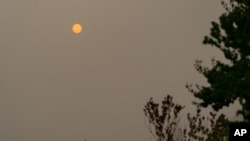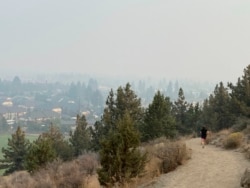The smoke from dozens of wildfires in the western United States is stretching clear across the country – and even pushing into Mexico, Canada and Europe. While the dangerous plumes are forcing people indoors along the West Coast, residents thousands of kilometers away in the East are seeing unusually hazy skies and remarkable sunsets.
The wildfires racing across tinder-dry landscape in California, Idaho, Oregon and Washington are extraordinary, but the long reach of their smoke isn't unprecedented. While there are only small pockets in the southeastern U.S. that are haze free, experts say the smoke poses less of a health concern for those who are farther away.
The sun was transformed into a perfect orange orb as it set over New York City on Tuesday. Photographs of it sinking behind the skyline and glinting through tree leaves flooded social media. On Wednesday, New Jersey residents described a yellow tinge to the overcast skies, and weather forecasters were kept busy explaining the phenomenon and making predictions as to how long the conditions would last.
Fire crews still working
On the opposite coast, air quality conditions were among the worst ever recorded. Smoke cloaked the Golden Gate Bridge and left Portland and Seattle in an ashy fog, as crews have exhausted themselves trying to keep the flames from consuming more homes and even wider swaths of forest.
Satellite images showed that smoke from the wildfires has traveled almost 8,000 kilometers to Britain and other parts of northern Europe, scientists said Wednesday.
Westerly winds, up high
The current weather system, which favors a westerly wind across the higher levels of the atmosphere, is to blame for the reach of the smoke, experts explained.
"We always seem, at times, to get the right combination of enough smoke and the upper-level jet stream to line up to bring that across the country, so we're just seeing this again," said Matt Solum with the National Weather Service's regional operations center in Salt Lake City, Utah. "It's definitely not the first time this has happened."
There could be some easing of the haze this weekend as a storm system is expected to move into the Pacific Northwest and could affect the conditions that helped the smoke travel across the country. But Solum said there's always a chance for more smoke and haze to shift around.
"Just due to all the wildfires that are going on, this is likely going to continue for a while," he said. "You might have ebbs and flows of that smoke, just depending on how the upper-level winds set up."
Making health problems worse
Kim Knowlton, a senior scientist with the Natural Resources Defense Council in New York City, said she woke up Wednesday to a red sunrise and more haze.
She said millions of people who live beyond the flames can end up dealing with diminished air quality, as it's not uncommon for wildfire smoke to travel hundreds of miles.
Although the health impacts are reduced the farther and higher into the atmosphere the smoke travels, Knowlton and her colleagues said the resulting haze can exacerbate existing problems such as asthma and add to ozone pollution.









